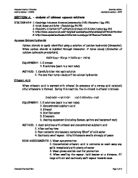The electrolyte is the substance which undergoes electrolysis.
The current flows from the cathode to the anode.
The electrons are pumped to one of the electrodes, which is the cathode (so it is negative), and away from one electrode, which is the anode (so it is positive).
So the cathode is full of electrons, so cations (positive ions) go there to gain electrons, get reduced. And the anode has less electrons, so anions (negative electrons) go there to loose electrons, get oxidised.
So the cations move to the cathode during electrolysis where they receive electrons to give them an overall neutral charge. This is called reduction, where electrons are gained.
Anions move to the anode during electrolysis. They lose the extra electrons, giving them an overall neutral charge. This is called oxidation, where electrons are lost.
Electrolysis of Zinc Chloride (ZnCl2)
You have to melt zinc chloride to be able to electrolyse it, so it needs constant heating.
Once you switch on the DC current, you will see bubbling around the anode, and you will find metallic zinc under the cathode after some time.
Explanation:
Once the power source is connected, the electrodes will be charged and be the anode and cathode.The negative chlorine ion will be attracted to the anode, where it will loose the extra electron to the positive anode, i.e. get reduced. This results in neutral chlorine atoms. These join in a covalent bond with another atom to form chlorine molecules, and are released as a gas.
The half equation:
2Cl—(l) → Cl2(g) + 2e—
The positive zinc ions are attracted to the cathode, where they gain the extra electrons (are oxidised), become neutral atoms and sink to the bottom, where they accumulate.
The half equation:
Zn2+(l) + 2e--→ Zn(l)
As electrons are used up in the cathode, there are spaces. These are filled up by the electrons gained at the anode, so electrons flow around, i.e. a current flows.
Uses of electrolysis
Electrolysis is used mainly to extract metals from their ores. These metals are above carbon in the reactivity series and include: K, Na, Ca, Mg, Al. The ore ,e.g. aluminium oxide or ‘bauxite’ for aluminium, is melted and poured into a huge vessel, where electrodes are placed and the power source is connected. The cathode is part of the container itself, so when electrolysis takes place, the metal ions are attracted to the bottom. Here they are reduced, become neutral ions and are tapped off to make ingots. The oxide is attracted to the carbon anode, where it is oxidised, looses electrons. It also forms bonds with the carbon to form CO2. This is one of the main disadvantages of electrolysis: firstly, the CO2 released is a greenhouse gas, secondly the carbon electrodes need to be constantly replaced as the carbon is being used up, and thirdly vast amounts of electricity and energy are required to melt the ore and for the power supply. This again increases global warming.
Electrolysis is used in the chlor-alkali industry to gain other useful substances too, such as chlorine, that is used in bleaches and swimming pools, hydrogen, used for making ammonia and margarine and sodium, for making soap, paper, ceramics etc.
Hydrogen as fuel in cars
Hydrogen is extremely flammable, it has the most amount of energy per gram. It is also a very light gas. If it is directly used in an internal combustion engine, the gas would immediately seep out of the shafts, and when ignited, it will explode violently.
So for any kind of use, it needs to be cooled to a liquid. This requires temperatures of -259.14oC, which is extremely hard and expensive to achieve even in a laboratory, and considerably harder to achieve in a medium sized car. Even if all this was possible, the possibility of hydrogen fuel stations are rare, so drivers would need to travel far for one.
This is why it is used from water, an abundant material, in fuel cells, using electrolysis.








